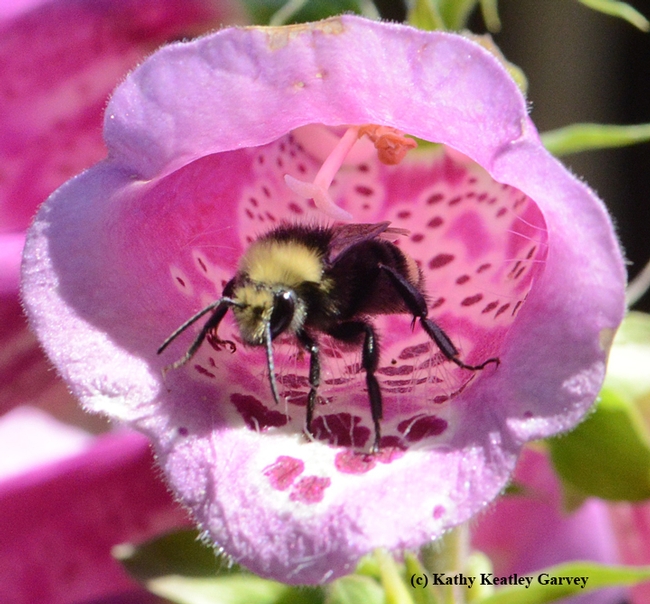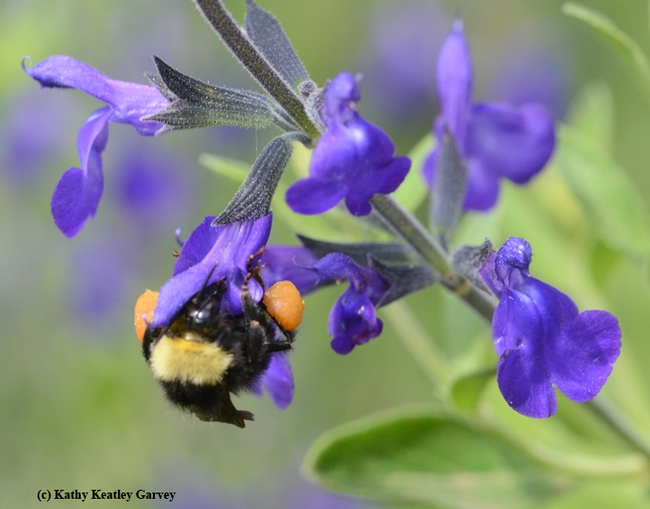
Ironically, it occurred the first day of National Pollinator Week.
Sujaya Rao, an Oregon State University (OSU) entomologist working the case, will be speaking on "The Buzz on Native Bumble Bees in Western Oregon: Why They Thrive and Die," from 12:10 to 1 p.m., Wednesday, May 18 in Room 230 of Wellman Hall. The talk, hosted by the UC Davis Department of Entomology and Nematology, is open to all interested persons.
Scientists attributed the massive bumble bee die-off to the active ingredient Dinotefuran, a neonicotinoid.
The Oregon Department of Agriculture (ODA) then put temporary restrictions on the use of 18 pesticides containing Dinotefuran.
The Xerces Society for Invertebrate Conservation was appalled by the die-off, as many of us were--and still are. Mace Vaughan, the Xerces Society's pollinator conservation director, said in a press release: “To our knowledge, this incident is the largest mass poisoning of bumble bees ever documented, and thankfully ODA is taking the issue very seriously. After interviewing the landscaping company that maintains dozens of ornamental trees around the Target parking lot, ODA investigators learned that the pesticide Dinotefuran had recently been applied. Investigators confirmed that Dinotefuran, sold under the trade name ‘Safari,' belongs to a class of insecticides called neonicotinoids that have been linked to bee deaths in recent years."
“Because neonicotinoids are long-lasting in plant tissues and can be found in flower nectar and pollen, and because they have been implicated in the global decline of honeybees, there have been growing concerns about their safety for pollinators,” the Xerces Society related in the press release.
Scott Black, executive director of the Xerces Society, noted that the pesticide was applied to the tree while it was flowering, an action that violates the product's instructions. “Beyond the fact that a pesticide was applied to plants while they were attracting large numbers of bees, in this case the pesticide was applied for purely cosmetic reasons. There was no threat to human health or the protection of farm crops that even factored into this decision.”
Rao, an OSU professor and field crop entomologist, specializes in pest management in grass seed and rotational crops, as well as native bee pollinators in agricultural and native landscapes. On her website, she lists her native bee research objectives as:
Determine the diversity and abundance of native bees in diverse cropping systems and surrounding habitats, and evaluate the impacts of bumble bees and honey bees in pollination. Specific areas of research:
- Red and arrow leaf clover
- Blueberries
- Cranberries
- Meadowfoam
It's difficult to think of 50,000 bumble bees dying.
How long has it been since you've seen a bumble bee? Last weekend a yellow-faced bumble bee, Bombus vosnesenskii, buzzed into our Vacaville yard and foraged in the foxgloves.
Then last week, another bumble bee, the black-faced Bombus californicus, frequented the "Purple Ginny" sage (Salvia coahuilensis) in the Häagen-Dazs Honey Bee Haven on Bee Biology Road, UC Davis. Operated by the UC Davis Department of Entomology and Nematology, the half-acre bee garden is open from dawn to dusk.
Now if we could just do more to protect the pollinators...
Attached Images:

A yellow-faced bumble bee, Bombus vosnesenskii, exits a foxglove in Vacaville, Calif. (Photo by Kathy Keatley Garvey)

A black-faced bumble bee, Bombus californicus, adjusting a heavy pollen load, visits "Purple Ginny" sage in the Häagen-Dazs Honey Bee Haven, UC Davis. (Photo by Kathy Keatley Garvey)